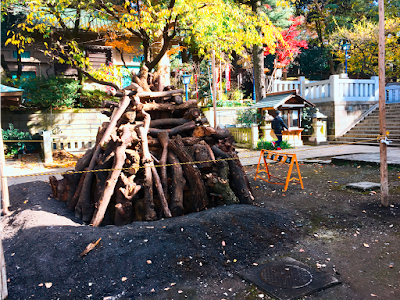From Bujinkan Santa Monica by Michael Glenn
at 摩利支天 徳大寺 Marishiten tokudaiji
The other night in Hatsumi Sensei's class I ran to grab a bokken from the weapon rack. When I returned, my training partner was waiting for my attack so he could try the muto Dori technique that Soke had just demonstrated.
When I cut down I had a great surprise. Hatsumi Sensei appeared from behind my training partner. He pushed my training partner aside so that I was cutting at Soke instead!
I thought that I hit something but Soke was beside me laughing. Somehow I missed. He said that I should learn this feeling.
This year one of the main themes of the training in Japan is Muto Dori. Anyone who has cut at Soke will tell you that he disappears or even splits in two.
That was what I experienced this time. It was like there were two of him. I hit one but that was an illusion.
I've often struggled to understand the reality behind this. Even though I can sometimes do this with my own students, the act remains elusive from any explanation.
But today I was lucky. Hatsumi Sensei gave us a big clue later on in the class. He showed a knife evasion and he said to move like the heat wave from 摩利支天 Marishiten. He said this as an aside to his uke and then he moved on.
Marishiten is a goddess I have some familiarity with. One of the very first shrines I visited in Japan was 摩利支天徳大寺 Marishiten tokudaiji in Tokyo. This place is a bit hidden in the middle of a very urban market.
Marishiten is very important for warriors and for ninja. She protects because she uses illusion to help us disappear from our enemies. In Mikkyō (esoteric Buddhism), there are mantra and mudra which are said to make a warrior invisible.
Marishiten appears like a ray of light or mirage. Her image is like a shimmering heat that bends light. Under her protection, anyone who attacks us would be blinded by illusion.
The illusion comes in rays of shimmering light. When you look, it is like staring into the sun, and Marishiten charges from within this brilliance.
When Soke said this a subtle light went off in my brain. This ineffable feeling he wanted me to understand was now more than just an odd experience I feel when I attack him. You have to see more than the illusion.
Maybe my training is to grasp the nature of the mirage and illusion that arises from Marishiten. This is one aspect of Hatsumi Sensei's lesson to me. But an odd side effect of this knowledge it is that I can now learn to counter this.
The mirage of Marishiten is a type of blindness. Once you can see and pierce through this veil, what lies beyond it grows clearer. I do not know what surprises Soke has waiting for me when I see past this layer, but I suspect it will open like the lotus blossom.
Marishiten is often depicted standing on a lotus. But her more angry form is shown standing on the back of a wild boar. Hopefully I will see flowers instead of beasts!



